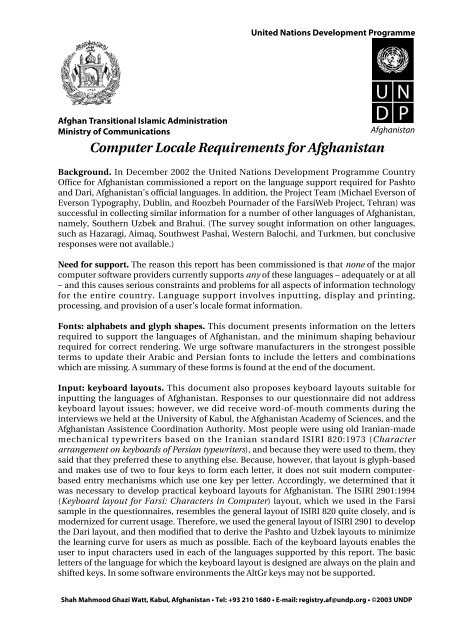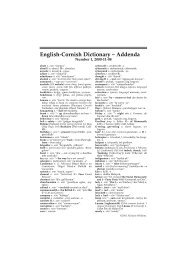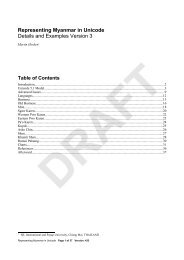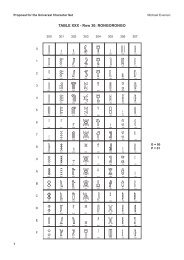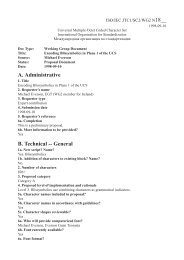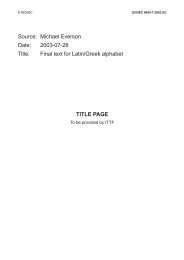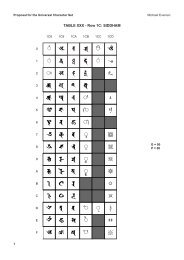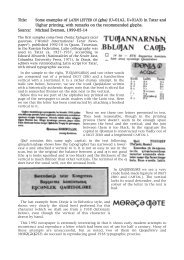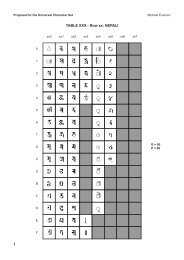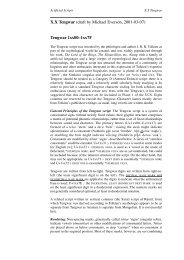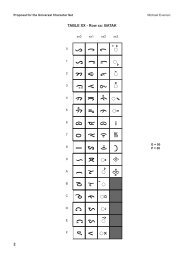Computer Locale Requirements for Afghanistan - Evertype
Computer Locale Requirements for Afghanistan - Evertype
Computer Locale Requirements for Afghanistan - Evertype
Create successful ePaper yourself
Turn your PDF publications into a flip-book with our unique Google optimized e-Paper software.
Afghan Transitional Islamic Administration<br />
Ministry of Communications<br />
United Nations Development Programme<br />
<strong>Computer</strong> <strong>Locale</strong> <strong>Requirements</strong> <strong>for</strong> <strong>Afghanistan</strong><br />
<strong>Afghanistan</strong><br />
Background. In December 2002 the United Nations Development Programme Country<br />
Office <strong>for</strong> <strong>Afghanistan</strong> commissioned a report on the language support required <strong>for</strong> Pashto<br />
and Dari, <strong>Afghanistan</strong>’s official languages. In addition, the Project Team (Michael Everson of<br />
Everson Typography, Dublin, and Roozbeh Pournader of the FarsiWeb Project, Tehran) was<br />
successful in collecting similar in<strong>for</strong>mation <strong>for</strong> a number of other languages of <strong>Afghanistan</strong>,<br />
namely, Southern Uzbek and Brahui. (The survey sought in<strong>for</strong>mation on other languages,<br />
such as Hazaragi, Aimaq, Southwest Pashai, Western Balochi, and Turkmen, but conclusive<br />
responses were not available.)<br />
Need <strong>for</strong> support. The reason this report has been commissioned is that none of the major<br />
computer software providers currently supports any of these languages – adequately or at all<br />
– and this causes serious constraints and problems <strong>for</strong> all aspects of in<strong>for</strong>mation technology<br />
<strong>for</strong> the entire country. Language support involves inputting, display and printing,<br />
processing, and provision of a user’s locale <strong>for</strong>mat in<strong>for</strong>mation.<br />
Fonts: alphabets and glyph shapes. This document presents in<strong>for</strong>mation on the letters<br />
required to support the languages of <strong>Afghanistan</strong>, and the minimum shaping behaviour<br />
required <strong>for</strong> correct rendering. We urge software manufacturers in the strongest possible<br />
terms to update their Arabic and Persian fonts to include the letters and combinations<br />
which are missing. A summary of these <strong>for</strong>ms is found at the end of the document.<br />
Input: keyboard layouts. This document also proposes keyboard layouts suitable <strong>for</strong><br />
inputting the languages of <strong>Afghanistan</strong>. Responses to our questionnaire did not address<br />
keyboard layout issues; however, we did receive word-of-mouth comments during the<br />
interviews we held at the University of Kabul, the <strong>Afghanistan</strong> Academy of Sciences, and the<br />
<strong>Afghanistan</strong> Assistence Coordination Authority. Most people were using old Iranian-made<br />
mechanical typewriters based on the Iranian standard ISIRI 820:1973 (Character<br />
arrangement on keyboards of Persian typewriters), and because they were used to them, they<br />
said that they preferred these to anything else. Because, however, that layout is glyph-based<br />
and makes use of two to four keys to <strong>for</strong>m each letter, it does not suit modern computerbased<br />
entry mechanisms which use one key per letter. Accordingly, we determined that it<br />
was necessary to develop practical keyboard layouts <strong>for</strong> <strong>Afghanistan</strong>. The ISIRI 2901:1994<br />
(Keyboard layout <strong>for</strong> Farsi: Characters in <strong>Computer</strong>) layout, which we used in the Farsi<br />
sample in the questionnaires, resembles the general layout of ISIRI 820 quite closely, and is<br />
modernized <strong>for</strong> current usage. There<strong>for</strong>e, we used the general layout of ISIRI 2901 to develop<br />
the Dari layout, and then modified that to derive the Pashto and Uzbek layouts to minimize<br />
the learning curve <strong>for</strong> users as much as possible. Each of the keyboard layouts enables the<br />
user to input characters used in each of the languages supported by this report. The basic<br />
letters of the language <strong>for</strong> which the keyboard layout is designed are always on the plain and<br />
shifted keys. In some software environments the AltGr keys may not be supported.<br />
Shah Mahmood Ghazi Watt, Kabul, <strong>Afghanistan</strong> • Tel: +93 210 1680 • E-mail: registry.af@undp.org • ©2003 UNDP
<strong>Computer</strong> <strong>Locale</strong> <strong>Requirements</strong> <strong>for</strong> <strong>Afghanistan</strong><br />
<strong>Locale</strong>s: ICU data. Additional data we collected has been <strong>for</strong>matted in locale specifications<br />
via the ICU (International Components <strong>for</strong> Unicode) website hosted at<br />
“http://oss.software.ibm.com/icu/”. In this way, the Afghan preferred <strong>for</strong>mats <strong>for</strong> language,<br />
date <strong>for</strong>mat (including month and day names and calendar), time <strong>for</strong>mat, number <strong>for</strong>mat,<br />
and currency <strong>for</strong>mat will be available to vendors who can provide software which will be of<br />
use to the people of <strong>Afghanistan</strong>, at governmental, business, academic, and local level.<br />
Whenever ICU locale data <strong>for</strong>mat is adequate <strong>for</strong> describing a part of the locale in<strong>for</strong>mation,<br />
the data in the ICU registry should be consulted <strong>for</strong> normative and accurate data. The<br />
specifications shown in this report are only in<strong>for</strong>mative examples in comparison with the<br />
ICU data files we have provided. However, in areas such as the Afghan calendar, which ICU<br />
locales cannot specify, the text in this report should be considered normative. (Note that the<br />
ICU files we have prepared are not standalone. They must be used in combination with<br />
other locale data, most importantly the “fa.txt” and “root.txt” files from ICU itself.)<br />
Ordering. Sorting order specification is also provided with the ICU locales. This deserves<br />
some additional discussion here. In our analysis of the Pashto, Dari, and Uzbek alphabets<br />
provided to us, together with our analysis of authoritative Pashto-English and Pashto-Pashto<br />
dictionaries, as well as comparison of a Dari-English dictionary with a number of bilingual<br />
and monolingual Persian dictionaries, we discovered that, with the exception of the<br />
treatment of hamza, the alphabets were all mutually compatible with respect to ordering.<br />
Because the ordering of “singular” hamza ( ) is of little consequence – it is rare and typically<br />
comes toward the end of a word – we determined that placing it between alef and beh would<br />
have two advantages: first, it would allow all of the languages of <strong>Afghanistan</strong> to avail of a<br />
single unified sort order, and second, it would enable the closely-related Persian languages,<br />
Dari and Farsi, to be sorted in the same way. It should be mentioned, however, that the<br />
order shown in this report is only the general ordering <strong>for</strong> letters, and does not show the<br />
ordering of less significant elements like the ordering of vowel marks or the handling of<br />
punctuation or Unicode control characters. The complete and exact ordering is the one<br />
specified in the ICU locale data files.<br />
We commend this report to the software vendors of the world, and trust that its<br />
specifications will be implemented as a matter of urgency, so that the people <strong>Afghanistan</strong><br />
can avail of the essential tools which many of us take <strong>for</strong> granted.<br />
˛ ¸<br />
Michael Everson Roozbeh Pournader<br />
Everson Typography, Dublin FarsiWeb Project, Tehran<br />
www.evertype.com www.farsiweb.info<br />
The latest version of this report, updates, and other resources (such as keyboard layout<br />
specifications in data files con<strong>for</strong>mant to ISO/IEC 9995, In<strong>for</strong>mation Technology – Keyboard<br />
layouts <strong>for</strong> text and office systems, and ICU data files based on this report) are available at<br />
“http://www.evertype.com/standards/af/”.<br />
© Copyright 2003 United Nations Development Programme, Michael Everson, and Roozbeh Pournader.<br />
Everyone is permitted to copy and distribute verbatim copies of this document, but changing it is not<br />
allowed. The authors welcome feedback from people who download and use the report and data files.<br />
Latest update: 2003-07-29<br />
©2003 UNDP • <strong>Computer</strong> <strong>Locale</strong> <strong>Requirements</strong> <strong>for</strong> <strong>Afghanistan</strong> • 2
<strong>Computer</strong> <strong>Locale</strong> <strong>Requirements</strong> <strong>for</strong> <strong>Afghanistan</strong><br />
The Pashto Alphabet<br />
The table below lists the letters used to write Pashto, including loanwords from Arabic.<br />
Our survey indicated a number of different sorting orders <strong>for</strong> Pashto. All respondants<br />
said that the alphabetic order was (reading from left to right) > > > > > .<br />
This is the order agreed on at a 1991 meeting of Pashto experts in Peshawar. It should be<br />
noted that the most authoritative dictionary, the Pas. tó-Pas. tó Descriptive Dictionary, 4<br />
volumes (Department of Linguistics, Institute of Languages and Literature, Academy of<br />
Sciences of <strong>Afghanistan</strong>, 1979–1987) uses the order > > > > > , as does<br />
Rahimi and Rohi’s Pashto-English Dictionary (1979). Materials <strong>for</strong> schoolchildren<br />
collected in Kabul, on the other hand, gave this same sequence as > > > > ><br />
. Nevertheless, we suggest that the order agreed at the 1991 Peshawar meeting is the<br />
best to follow.<br />
In the list below, the Unicode letters which sort as separate letters at the first level are<br />
given flush to the left margin, and letters which sort at the second level are indented. We<br />
have also given the Urdu letters which are used in older Pashto orthographies to show<br />
how Pashto data in that orthography will sort.<br />
Unicode Name isolated final medial initial Arabic Dari Pashto Uzbek Brahui<br />
0622 ā ] — — • • • •<br />
0627 alif ] — — • • • • •<br />
0623 alif-hamza ] — — • • • • •<br />
0671 alif-wasla ] — — •<br />
0625 al.-h.-below ] — — •<br />
0621 hamza — — — • • • • •<br />
0628 be ] ]] ] • • • • •<br />
067E pe ] ]] ] • • • •<br />
062A te ] ]] ] • • • • •<br />
067C e ] ]] ] •<br />
0679 Urdu e ] ]] ] •<br />
062B se ] ]] ] • • • • •<br />
062C jim ] ]] ] • • • • •<br />
0681 ǰe ] ]] ] •<br />
0686 če ] ]] ] • • • •<br />
0685 ce ] ]] ] •<br />
062D he ] ]] ] • • • • •<br />
©2003 UNDP • <strong>Computer</strong> <strong>Locale</strong> <strong>Requirements</strong> <strong>for</strong> <strong>Afghanistan</strong> • 3
<strong>Computer</strong> <strong>Locale</strong> <strong>Requirements</strong> <strong>for</strong> <strong>Afghanistan</strong><br />
Unicode Name isolated final medial initial Arabic Dari Pashto Uzbek Brahui<br />
062E xe ] ]] ] • • • • •<br />
062F dāl ] — — • • • • •<br />
0689 āl ] — — •<br />
0688 Urdu āl ] — — •<br />
0630 zāl ] — — • • • • •<br />
0631 re ] — — • • • • •<br />
0693 e ] — — •<br />
0691 Urdu e ] — — •<br />
0632 ze ] — — • • • • •<br />
0698 že ] — — • • • •<br />
0696 e ] — — •<br />
0633 sin ] ]] ] • • • • •<br />
0634 šin ] ]] ] • • • • •<br />
069A in ] ]] ] •<br />
0635 swāt ] ]] ] • • • • •<br />
0636 zād ] ]] ] • • • • •<br />
0637 twe ] ]] ] • • • • •<br />
0638 zwe ] ]] ] • • • • •<br />
0639 ˁayn ] ]] ] • • • • •<br />
063A ǧayn ] ]] ] • • • • •<br />
0641 fe ] ]] ] • • • • •<br />
0642 qāf ] ]] ] • • • • •<br />
06A9 kāf ] ]] ] • • • •<br />
0643 Arabic kāf ] ]] ] •<br />
06AB gāf ] ]] ] •<br />
06AF Persian gāf ] ]] ] • • •<br />
0644 lām ] ]] ] • • • • •<br />
06B7 Brahui lhām ] ]] ] •<br />
0645 mim ] ]] ] • • • • •<br />
0646 nun ] ]] ] • • • • •<br />
©2003 UNDP • <strong>Computer</strong> <strong>Locale</strong> <strong>Requirements</strong> <strong>for</strong> <strong>Afghanistan</strong> • 4
<strong>Computer</strong> <strong>Locale</strong> <strong>Requirements</strong> <strong>for</strong> <strong>Afghanistan</strong><br />
Unicode Name isolated final medial initial Arabic Dari Pashto Uzbek Brahui<br />
06BA nun ghunna ] — — •<br />
06BC un ] ]] ] •<br />
0648 wāw ] — — • • • • •<br />
0624 wāw hamza ] — — • • • • •<br />
06C7 Uzbek u ] — — •<br />
06C9 Uzbek o ] — — •<br />
0647 he ] ]] ] • • • • •<br />
0629 gǝda te ] — — • • • • •<br />
06CC ye ] ]] ] • • • •<br />
0649 alef maksura — — ]] ] •<br />
06D2 Urdu ye ] — — •<br />
064A saxta ye ] — — • • •<br />
06D0 pasta ye ] ] ] • •<br />
06CD ǝǰina ye ] — — •<br />
0626 feˁli ye ] ] ] • • • •<br />
Note. Since the shapes of the ] initial and ]] medial <strong>for</strong>ms of the Pashto letters ye<br />
(U+06CC) and saxta ye (U+064A) are exactly the same, to avoid encoding ambiguities<br />
in Pashto data – and its known implications in security-related issues including possible<br />
Pashto domain names – we recommend that the Unicode character <strong>for</strong> saxta ye, namely<br />
U+064A, never be used in initial and medial <strong>for</strong>ms in Pashto data. Where input data is<br />
explicitly known to be in Pashto, applications should automatically replace such usage<br />
in the input data (<strong>for</strong> example, in keyboard input) with the normal ye character, namely<br />
U+06CC. Applications may not automatically change U+064A to U+06CC in Pashto<br />
input if it is used in final or isolated <strong>for</strong>ms.<br />
©2003 UNDP • <strong>Computer</strong> <strong>Locale</strong> <strong>Requirements</strong> <strong>for</strong> <strong>Afghanistan</strong> • 5
<strong>Computer</strong> <strong>Locale</strong> <strong>Requirements</strong> <strong>for</strong> <strong>Afghanistan</strong><br />
The Dari Alphabet<br />
The table below lists the letters used to write Dari, including loanwords from Arabic. In<br />
the list below, the Unicode letters which sort as separate letters at the first level are given<br />
flush to the left margin, and letters which sort at the second level are indented. We have<br />
also given the Urdu letters which are used in older Pashto orthographies to show how<br />
Pashto data in that orthography will sort.<br />
Unicode Name isolated final medial initial Arabic Dari Pashto Uzbek Brahui<br />
0622 ā ] — — • • • •<br />
0627 alef ] — — • • • • •<br />
0623 alef-hamza ] — — • • • • •<br />
0671 alif-wasla ] — — •<br />
0625 al.-h.-below ] — — •<br />
0621 hamza — — — • • • • •<br />
0628 be ] ]] ] • • • • •<br />
067E pe ] ]] ] • • • •<br />
062A te ] ]] ] • • • • •<br />
067C Pashto e ] ]] ] •<br />
0679 Urdu e ] ]] ] •<br />
062B se ] ]] ] • • • • •<br />
062C jim ] ]] ] • • • • •<br />
0681 Pashto ǰe ] ]] ] •<br />
0686 če ] ]] ] • • • •<br />
0685 Pashto ce ] ]] ] •<br />
062D he ] ]] ] • • • • •<br />
062E xe ] ]] ] • • • • •<br />
062F dāl ] — — • • • • •<br />
0689 Pashto āl ] — — •<br />
0688 Urdu āl ] — — •<br />
0630 zāl ] — — • • • • •<br />
0631 re ] — — • • • • •<br />
©2003 UNDP • <strong>Computer</strong> <strong>Locale</strong> <strong>Requirements</strong> <strong>for</strong> <strong>Afghanistan</strong> • 6
<strong>Computer</strong> <strong>Locale</strong> <strong>Requirements</strong> <strong>for</strong> <strong>Afghanistan</strong><br />
Unicode Name isolated final medial initial Arabic Dari Pashto Uzbek Brahui<br />
0693 Pashto e ] — — •<br />
0691 Urdu e ] — — •<br />
0632 ze ] — — • • • • •<br />
0698 že ] — — • • • •<br />
0696 Pashto e ] — — •<br />
0633 sin ] ]] ] • • • • •<br />
0634 šin ] ]] ] • • • • •<br />
069A Pashto in ] ]] ] •<br />
0635 sād ] ]] ] • • • • •<br />
0636 zād ] ]] ] • • • • •<br />
0637 tā ] ]] ] • • • • •<br />
0638 zā ] ]] ] • • • • •<br />
0639 ayn ] ]] ] • • • • •<br />
063A qayn ] ]] ] • • • • •<br />
0641 fe ] ]] ] • • • • •<br />
0642 qāf ] ]] ] • • • • •<br />
06A9 kāf ] ]] ] • • • •<br />
0643 Arabic kāf ] ]] ] •<br />
06AB Pashto gāf ] ]] ] •<br />
06AF gāf ] ]] ] • • •<br />
0644 lām ] ]] ] • • • • •<br />
06B7 Brahui lhām ] ]] ] •<br />
0645 mīm ] ]] ] • • • • •<br />
0646 nūn ] ]] ] • • • • •<br />
06BA nūn ghunna ] — — •<br />
06BC Pashto ūn ] ]] ] •<br />
0648 vāv ] — — • • • • •<br />
0624 vāv hamza ] — — • • • • •<br />
06C7 Uzbek u ] — — •<br />
06C9 Uzbek o ] — — •<br />
©2003 UNDP • <strong>Computer</strong> <strong>Locale</strong> <strong>Requirements</strong> <strong>for</strong> <strong>Afghanistan</strong> • 7
<strong>Computer</strong> <strong>Locale</strong> <strong>Requirements</strong> <strong>for</strong> <strong>Afghanistan</strong><br />
Unicode Name isolated final medial initial Arabic Dari Pashto Uzbek Brahui<br />
0647 he ] ]] ] • • • • •<br />
0629 te-ye gerd ] — — • • • • •<br />
06CC ye ] ]] ] • • • •<br />
0649alef-e maqsura — — ]] ] •<br />
06D2 Urdu ye ] — — •<br />
064A saxta ye ] — — • • •<br />
06D0 pasta ye ] ] ] • •<br />
06CD ǝǰina ye ] — — •<br />
0626 ye hamza ] ] ] • • • •<br />
©2003 UNDP • <strong>Computer</strong> <strong>Locale</strong> <strong>Requirements</strong> <strong>for</strong> <strong>Afghanistan</strong> • 8
<strong>Computer</strong> <strong>Locale</strong> <strong>Requirements</strong> <strong>for</strong> <strong>Afghanistan</strong><br />
The Southern Uzbek Alphabet<br />
The table below lists the letters used to write Southern Uzbek, including loanwords from<br />
Arabic. This is a new official orthography the development of which was inspired by the<br />
UNDP project. In the list below, the Unicode letters which sort as separate letters at the<br />
first level are given flush to the left margin, and letters which sort at the second level are<br />
indented. We have also given the Urdu letters which are used in older Pashto<br />
orthographies to show how Pashto data in that orthography will sort.<br />
Unicode Name isolated final medial initial Arabic Dari Pashto Uzbek Brahui<br />
0622 alef-madha ] — — • • • •<br />
0627 alef ] — — • • • • •<br />
0623 alef-hamza ] — — • • • • •<br />
0671 alif-wasla ] — — •<br />
0625 al.-h.-below ] — — •<br />
0621 hamza — — — • • • • •<br />
0628 beh ] ]] ] • • • • •<br />
067E peh ] ]] ] • • • •<br />
062A teh ] ]] ] • • • • •<br />
067C Pashto eh ] ]] ] •<br />
0679 Urdu eh ] ]] ] •<br />
062B seh ] ]] ] • • • • •<br />
062C jeem ] ]] ] • • • • •<br />
0681 Pashto ǰeh ] ]] ] •<br />
0686 cheh ] ]] ] • • • •<br />
0685 Pashto ceh ] ]] ] •<br />
062D heh ] ]] ] • • • • •<br />
062E kheh ] ]] ] • • • • •<br />
062F dal ] — — • • • • •<br />
0689 Pashto al ] — — •<br />
0688 Urdu al ] — — •<br />
0630 zal ] — — • • • • •<br />
0631 reh ] — — • • • • •<br />
©2003 UNDP • <strong>Computer</strong> <strong>Locale</strong> <strong>Requirements</strong> <strong>for</strong> <strong>Afghanistan</strong> • 9
<strong>Computer</strong> <strong>Locale</strong> <strong>Requirements</strong> <strong>for</strong> <strong>Afghanistan</strong><br />
Unicode Name isolated final medial initial Arabic Dari Pashto Uzbek Brahui<br />
0693 Pashto eh ] — — •<br />
0691 Urdu eh ] — — •<br />
0632 zeh ] — — • • • • •<br />
0698 zheh ] — — • • • •<br />
0696 Pashto eh ] — — •<br />
0633 sin ] ]] ] • • • • •<br />
0634 shin ] ]] ] • • • • •<br />
069A Pashto in ] ]] ] •<br />
0635 swad ] ]] ] • • • • •<br />
0636 zwad ] ]] ] • • • • •<br />
0637 tuy ] ]] ] • • • • •<br />
0638 zuy ] ]] ] • • • • •<br />
0639 ’ain ] ]] ] • • • • •<br />
063A ghain ] ]] ] • • • • •<br />
0641 feh ] ]] ] • • • • •<br />
0642 qaf ] ]] ] • • • • •<br />
06A9 kaf ] ]] ] • • • •<br />
0643 Arabic kaf ] ]] ] •<br />
06AB Pashto gaf ] ]] ] •<br />
06AF gaf ] ]] ] • • •<br />
0644 lam ] ]] ] • • • • •<br />
06B7 Brahui lham ] ]] ] •<br />
0645 meem ] ]] ] • • • • •<br />
0646 nuun ] ]] ] • • • • •<br />
06BA nuun ghunna ] — — •<br />
06BC Pashto uun ] ]] ] •<br />
0648 waw ] — — • • • • •<br />
0624 waw hamza ] — — • • • • •<br />
06C7 u ] — — •<br />
06C9 o’ ] — — •<br />
©2003 UNDP • <strong>Computer</strong> <strong>Locale</strong> <strong>Requirements</strong> <strong>for</strong> <strong>Afghanistan</strong> • 10
<strong>Computer</strong> <strong>Locale</strong> <strong>Requirements</strong> <strong>for</strong> <strong>Afghanistan</strong><br />
Unicode Name isolated final medial initial Arabic Dari Pashto Uzbek Brahui<br />
0647 heh ] ]] ] • • • • •<br />
0629 teh marbuta ] — — • • • • •<br />
06CC yih ] ]] ] • • • •<br />
0649 alef maksura — — ]] ] •<br />
06D2 Urdu yih ] — — •<br />
064A yeeh ] — — • • •<br />
06D0 yeh ] ] ] • •<br />
06CD ǝǰina yih ] — — •<br />
0626 yih hamza ] ] ] • • • •<br />
Note. To avoid encoding ambiguities in Uzbek data, and its known implications in<br />
security-related issues including possible Uzbek Internet domain names, we<br />
recommend that the Uzbek letter u always be encoded as U+06C7 and never as a<br />
sequence of waw and a damma. Where input data is explicitly known to be in Uzbek,<br />
applications should automatically replace a waw followed by a damma in the input data<br />
(<strong>for</strong> example, in keyboard input) with the U+06C7 character.<br />
©2003 UNDP • <strong>Computer</strong> <strong>Locale</strong> <strong>Requirements</strong> <strong>for</strong> <strong>Afghanistan</strong> • 11
<strong>Computer</strong> <strong>Locale</strong> <strong>Requirements</strong> <strong>for</strong> <strong>Afghanistan</strong><br />
The Brahui Alphabet<br />
The table below lists the letters used to write Brahui, including loanwords from Arabic.<br />
Brahui is not widely written either in Pakistan, where most Brahui speakers live, or in<br />
<strong>Afghanistan</strong>. An expert respondant in<strong>for</strong>med us that in Pakistan, Brahui speakers use<br />
Urdu orthography with the addition of one letter, lhām. If Brahui is written in<br />
<strong>Afghanistan</strong>, it may prefer the Pashto letters such as e to the corresponding Urdu <br />
e. We have no evidence of this, but have given the Brahui alphabet here in order to<br />
ensure the support of its own unique letter.<br />
In the list below, the Unicode letters which sort as separate letters at the first level are<br />
given flush to the left margin, and letters which sort at the second level are indented. We<br />
have also given the Urdu letters which are used in older Pashto orthographies to show<br />
how Pashto data in that orthography will sort.<br />
Unicode Name isolated final medial initial Arabic Dari Pashto Uzbek Brahui<br />
0622 ā ] — — • • • • •<br />
0627 alif ] — — • • • • •<br />
0623 alif-hamza ] — — • • • • •<br />
0671 alif-wasla ] — — •<br />
0625 al.-h.-below ] — — •<br />
0621 hamza — — — • • • • •<br />
0628 be ] ]] ] • • • • •<br />
067E pe ] ]] ] • • • •<br />
062A te ] ]] ] • • • • •<br />
067C e ] ]] ] •<br />
0679 Urdu e ] ]] ] •<br />
062B se ] ]] ] • • • • •<br />
062C jim ] ]] ] • • • • •<br />
0681 ǰe ] ]] ] •<br />
0686 če ] ]] ] • • • •<br />
0685 ce ] ]] ] •<br />
062D he ] ]] ] • • • • •<br />
062E xe ] ]] ] • • • • •<br />
062F dāl ] — — • • • • •<br />
©2003 UNDP • <strong>Computer</strong> <strong>Locale</strong> <strong>Requirements</strong> <strong>for</strong> <strong>Afghanistan</strong> • 12
<strong>Computer</strong> <strong>Locale</strong> <strong>Requirements</strong> <strong>for</strong> <strong>Afghanistan</strong><br />
Unicode Name isolated final medial initial Arabic Dari Pashto Uzbek Brahui<br />
0689 āl ] — — •<br />
0688 Urdu āl ] — — •<br />
0630 zāl ] — — • • • • •<br />
0631 re ] — — • • • • •<br />
0693 e ] — — •<br />
0691 Urdu e ] — — •<br />
0632 ze ] — — • • • • •<br />
0698 že ] — — • • • •<br />
0696 e ] — — •<br />
0633 sin ] ]] ] • • • • •<br />
0634 šin ] ]] ] • • • • •<br />
069A in ] ]] ] •<br />
0635 swāt ] ]] ] • • • • •<br />
0636 zād ] ]] ] • • • • •<br />
0637 twe ] ]] ] • • • • •<br />
0638 zwe ] ]] ] • • • • •<br />
0639 ˁayn ] ]] ] • • • • •<br />
063A ǧayn ] ]] ] • • • • •<br />
0641 fe ] ]] ] • • • • •<br />
0642 qāf ] ]] ] • • • • •<br />
06A9 kāf ] ]] ] • • • •<br />
0643 Arabic kāf ] ]] ] •<br />
06AB Pashto gāf ] ]] ] •<br />
06AF gāf ] ]] ] • • •<br />
0644 lām ] ]] ] • • • • •<br />
06B7 lhām ] ]] ] •<br />
0645 mim ] ]] ] • • • • •<br />
0646 nun ] ]] ] • • • • •<br />
06BA nun ghunna ] — — •<br />
06BC un ] ]] ] •<br />
©2003 UNDP • <strong>Computer</strong> <strong>Locale</strong> <strong>Requirements</strong> <strong>for</strong> <strong>Afghanistan</strong> • 13
<strong>Computer</strong> <strong>Locale</strong> <strong>Requirements</strong> <strong>for</strong> <strong>Afghanistan</strong><br />
Unicode Name isolated final medial initial Arabic Dari Pashto Uzbek Brahui<br />
0648 wāw ] — — • • • • •<br />
0624 wāw hamza ] — — • • • • •<br />
06C7 Uzbek u ] — — •<br />
06C9 Uzbek o ] — — •<br />
0647 he ] ]] ] • • • • •<br />
0629 te marbuta ] — — • • • • •<br />
06CC ye ] ]] ] • • • •<br />
0649 alef maksura — — ]] ] •<br />
06D2 Urdu ye ] — — •<br />
064A saxta ye ] — — • • •<br />
06D0 pasta ye ] ] ] • •<br />
06CD ǝǰina ye ] — — •<br />
0626 ye hamza ] ] ] • • • •<br />
©2003 UNDP • <strong>Computer</strong> <strong>Locale</strong> <strong>Requirements</strong> <strong>for</strong> <strong>Afghanistan</strong> • 14
<strong>Computer</strong> <strong>Locale</strong> <strong>Requirements</strong> <strong>for</strong> <strong>Afghanistan</strong><br />
Glyph-shape <strong>Requirements</strong> <strong>for</strong> <strong>Afghanistan</strong><br />
The table below lists the glyphs not usually found in most Arabic fonts, which it is<br />
essential to support in order to enable the people of <strong>Afghanistan</strong> to write and process<br />
their languages.<br />
Unicode Name isolated final medial initial Dari Pashto Uzbek Brahui<br />
067E pe ] ]] ] • • • •<br />
067C Pashto e ] ]] ] •<br />
0679 Urdu e ] ]] ] •<br />
0681 ǰe ] ]] ] •<br />
0686 če ] ]] ] • • • •<br />
0685 ce ] ]] ] •<br />
0689 āl ] — — •<br />
0688 Urdu āl ] — — •<br />
0693 e ] — — •<br />
0691 Urdu e ] — — •<br />
0698 že ] — — • • • •<br />
0696 e ] — — •<br />
069A in ] ]] ] •<br />
06A9 Persian kāf ] ]] ] • • • •<br />
06AB Pashto gāf ] ]] ] •<br />
06AF gāf ] ]] ] • • •<br />
06B7 lhām ] ]] ] •<br />
06BA nun ghunna ] — — •<br />
06BC un ] ]] ] •<br />
06C7 Uzbek u ] — — •<br />
06C9 Uzbek o ] — — •<br />
06CC ye ] ]] ] • • • •<br />
06D2 Urdu ye ] — — •<br />
06D0 pasta ye ] ] ] • •<br />
06CD ǝǰina ye ] — — •<br />
©2003 UNDP • <strong>Computer</strong> <strong>Locale</strong> <strong>Requirements</strong> <strong>for</strong> <strong>Afghanistan</strong> • 15
<strong>Computer</strong> <strong>Locale</strong> <strong>Requirements</strong> <strong>for</strong> <strong>Afghanistan</strong><br />
Almost all of the languages used in <strong>Afghanistan</strong> require the use of diacritical marks<br />
which follow a base letter, to make pronunciation or grammar usage clear. These marks<br />
are known by different names in the different languages of <strong>Afghanistan</strong>, but are listed<br />
here with their Unicode character names. Font and application developers should<br />
ensure that they support these marks in their products. The zwarakay at the bottom of<br />
the list is used in some Pashto educational materials, and as a result of this survey is now<br />
being proposed <strong>for</strong> addition to the Unicode Standard. Until such time as it has been<br />
<strong>for</strong>mally encoded, we recommend the Private Use Area code position U+E659 <strong>for</strong> the<br />
zwarakay.<br />
Unicode Name<br />
064B fathatan e<br />
064C dammatan g<br />
064D kasratan f<br />
064E fatha a<br />
064F damma c<br />
0650 kasra b<br />
Unicode Name<br />
0651 shadda h<br />
0652 sukun d<br />
0653 maddah above l<br />
0654 hamza above k<br />
0670 superscript alef j<br />
(E659) zwarakay i<br />
One additional character appears to be in wide use by local banks and accountants in<br />
<strong>Afghanistan</strong>, namely the afghani sign, q. This character is also being proposed <strong>for</strong><br />
addition to the Unicode Standard. Until such time as it has been <strong>for</strong>mally encoded, we<br />
recommend the Private Use Area code position U+E0B4 <strong>for</strong> the afghani sign. It should be<br />
noted that glyph variants <strong>for</strong> this character exist, <strong>for</strong> example r and p, but in our<br />
discussions several experts indicated that the first one shown above is the most original<br />
and may there<strong>for</strong>e be more appropriate. Research on the best glyph shape is still<br />
ongoing. As of this writing, neither the Ministry of Finance nor Da <strong>Afghanistan</strong> Bank had<br />
<strong>for</strong>mally adopted this symbol <strong>for</strong> use, although it is in use in both the public and private<br />
sectors.<br />
It should also be mentioned that certain punctuation marks and control characters are<br />
used in Afghan computing. We have listed all of these characters on the collectivelyequivalent<br />
keyboard layouts. Font developers are expected to include all of these<br />
additional characters in fonts which are intended to support Afghan languages.<br />
©2003 UNDP • <strong>Computer</strong> <strong>Locale</strong> <strong>Requirements</strong> <strong>for</strong> <strong>Afghanistan</strong> • 16
Pashto keyboard layout <strong>for</strong> <strong>Afghanistan</strong><br />
by Michael Everson, Roozbeh Pournader, Said Marjan Zazai, & Mohammad Tamim Noori, 2003-07-05<br />
+<br />
)<br />
(<br />
»<br />
«<br />
×<br />
` ^<br />
٪<br />
_ %<br />
6<br />
q<br />
^ $<br />
/<br />
‘<br />
!<br />
÷<br />
=<br />
<br />
- _<br />
٠ RL<br />
M<br />
٩ LR<br />
M<br />
٧ & ٨ •<br />
8<br />
٣ #<br />
٢ @ 3<br />
١ `<br />
ZWJ ~<br />
delete<br />
=<br />
-<br />
0<br />
9<br />
7<br />
5<br />
4<br />
2<br />
1<br />
`<br />
<strong>Computer</strong> <strong>Locale</strong> <strong>Requirements</strong> <strong>for</strong> <strong>Afghanistan</strong><br />
]<br />
}<br />
[<br />
<br />
<br />
h<br />
a<br />
b<br />
c<br />
e<br />
f<br />
g<br />
d<br />
{<br />
"<br />
'<br />
j<br />
i<br />
€ π ∫ ∑<br />
R<br />
T<br />
Y<br />
l<br />
°<br />
return<br />
]<br />
[<br />
P<br />
O<br />
I<br />
U<br />
E<br />
W<br />
tab Q<br />
*<br />
\ |<br />
؛<br />
\<br />
:<br />
<br />
<br />
><br />
<br />
<<br />
K<br />
<br />
<br />
<br />
<br />
<br />
<br />
<br />
<br />
<br />
<br />
<br />
<br />
'<br />
;<br />
L<br />
J<br />
H<br />
G<br />
F<br />
D<br />
S<br />
caps lock A<br />
<br />
/ <br />
.<br />
<br />
،<br />
,<br />
<br />
<br />
<br />
<br />
<br />
ZW<br />
NJ<br />
<br />
<br />
k<br />
∏<br />
<br />
;<br />
<br />
?<br />
shift<br />
/<br />
.<br />
,<br />
M<br />
N<br />
B<br />
V<br />
C<br />
X<br />
Z<br />
shift<br />
Guide to the key assignments, reading top-down and left-right<br />
Unshifted:<br />
ZWJ, one, two, three, four, five, six, seven, eight, nine, zero, hyphen, equals<br />
shift altgr<br />
shift<br />
zād, swāt, se, qāf, fe, ǧayn, ˁayn, he, xe, he, jim, če<br />
šin, sin, ye, be, lām, alif, te, nun, mim, kāf, gāf, backslash<br />
plain altgr<br />
ǝǰina-ye, feˁli-ye, ze, re, zāl, dāl, e, vāv, e, slash<br />
Shifted:<br />
division, exclamation, thousands, decimals, afghanǝy, percent, multiplication, guillemet, guillemet, parenthesis, parenthesis, kashida, plus<br />
Unshifted spacebar →<br />
SPACE<br />
sukun, dammatan, kasratan, fathatan, damma, kasra, fatha, shadda, ǰe, ce, square-bracket, square-bracket<br />
in, pasta-ye, saxta-ye, pe, alef-hamza, ā, e, ūn, gǝda-te, colon, semicolon, asterisk<br />
©2003 UNDP • <strong>Computer</strong> <strong>Locale</strong> <strong>Requirements</strong> <strong>for</strong> <strong>Afghanistan</strong> • 17<br />
Shifted spacebar →<br />
ZERO WIDTH NON-JOINER<br />
zwe, twe, že, hamza, ZWNJ, āl, wāw-hamza, comma, full-stop, question<br />
Alt-Gr:<br />
tilde, grave, at, number, dollar, percent, circumflex, ampersand, bullet, LRM, RLM, underscore, —<br />
degree, maddah, euro, ornament-parenthesis, ornament-parenthesis, alif-below, zwarakay, alif-above, apostrophe, quote, curly-bracket, curly-bracket<br />
Alt-Gr spacebar →<br />
NO-BREAK SPACE<br />
—, urdu-ye, alif-maksura, nun-ghunna, brahui-lhām, alif-wasla, urdu-e, less-than, greater-than, arabic-kāf, persian-gāf, vertical-bar<br />
question, semicolon, hamza-below, hamza-above, alif-hamza-below, urdu-āl, urdu-e, comma, uzbek-u, uzbek-o
<strong>Computer</strong> <strong>Locale</strong> <strong>Requirements</strong> <strong>for</strong> <strong>Afghanistan</strong><br />
Keyboard layouts <strong>for</strong> <strong>Afghanistan</strong><br />
Key assignments <strong>for</strong> Pashto, using ISO/IEC 9995 notation:<br />
Unshifted Shifted AltGr<br />
TLDE 200D 00F7 007E<br />
E01 06F1 0021 0060<br />
E02 06F2 066C 0040<br />
E03 06F3 066B 0023<br />
E04 06F4 AFGHANI 0024<br />
E05 06F5 066A 0025<br />
E06 06F6 00D7 005E<br />
E07 06F7 00BB 0026<br />
E08 06F8 00AB 2022<br />
E09 06F9 0029 200E<br />
E10 06F0 0028 200F<br />
E11 002D 0640 005F<br />
E12 003D 002B <br />
D01 0636 0652 00B0<br />
D02 0635 064C 0653<br />
D03 062B 064D 20AC<br />
D04 0642 064B FD3E<br />
D05 0641 064F FD3F<br />
D06 063A 0650 0656<br />
D07 0639 064E ZWARAKAY<br />
D08 0647 0651 0670<br />
D09 062E 0681 0027<br />
D10 062D 0685 0022<br />
D11 062C 005D 007D<br />
D12 0686 005B 007B<br />
C01 0634 069A <br />
C02 0633 0626 06D2<br />
C03 06CC 064A 0649<br />
C04 0628 067E 06BA<br />
C05 0644 0623 06B7<br />
C06 0627 0622 0671<br />
C07 062A 067C 0679<br />
C08 0646 06BC 003E<br />
C09 0645 0629 003C<br />
C10 06A9 003A 0643<br />
C11 06AB 061B 06AF<br />
B01 06CD 0638 003F<br />
B02 06D0 0637 003B<br />
B03 0632 0698 0655<br />
B04 0631 0621 0654<br />
B05 0630 200C 0625<br />
B06 062F 0689 0688<br />
B07 0693 0624 0691<br />
B08 0648 060C 002C<br />
B09 0696 002E 06C7<br />
B10 002F 061F 06C9<br />
BKSL 005C 002A 007C<br />
SPCE 0020 200C 00A0<br />
©2003 UNDP • <strong>Computer</strong> <strong>Locale</strong> <strong>Requirements</strong> <strong>for</strong> <strong>Afghanistan</strong> • 18
Dari keyboard layout <strong>for</strong> <strong>Afghanistan</strong><br />
by Michael Everson & Roozbeh Pournader, 2003-07-05<br />
+<br />
<br />
- _<br />
)<br />
(<br />
، *<br />
٧ & ٨ •<br />
8<br />
×<br />
` ^<br />
٪<br />
_ %<br />
6<br />
q<br />
^ $<br />
/<br />
‘<br />
!<br />
÷<br />
=<br />
٠ RL<br />
M<br />
٩ LR<br />
M<br />
٣ #<br />
٢ @ 3<br />
١ `<br />
ZWJ ~<br />
delete<br />
=<br />
-<br />
0<br />
9<br />
7<br />
5<br />
4<br />
2<br />
1<br />
`<br />
<strong>Computer</strong> <strong>Locale</strong> <strong>Requirements</strong> <strong>for</strong> <strong>Afghanistan</strong><br />
}<br />
<br />
{<br />
]<br />
[<br />
h<br />
a<br />
b<br />
c<br />
e<br />
f<br />
g<br />
d<br />
<br />
"<br />
'<br />
∏<br />
i<br />
€ π ∫ ∑<br />
R<br />
T<br />
Y<br />
<br />
°<br />
return<br />
]<br />
[<br />
P<br />
O<br />
I<br />
U<br />
E<br />
W<br />
tab Q<br />
|<br />
\ ?<br />
؛<br />
\<br />
:<br />
;<br />
»<br />
<br />
«<br />
<br />
K<br />
<br />
<br />
<br />
<br />
<br />
<br />
<br />
<br />
<br />
<br />
S<br />
'<br />
;<br />
L<br />
J<br />
H<br />
G<br />
F<br />
D<br />
caps lock A<br />
<br />
/ <br />
><br />
. <br />
<<br />
k<br />
j<br />
<br />
l<br />
,<br />
<br />
<br />
,<br />
<br />
ZW<br />
NJ<br />
<br />
<br />
<br />
<br />
<br />
<br />
shift<br />
/<br />
.<br />
M<br />
N<br />
B<br />
V<br />
C<br />
X<br />
Z<br />
shift<br />
Guide to the key assignments, reading top-down and left-right<br />
Unshifted:<br />
ZWJ, one, two, three, four, five, six, seven, eight, nine, zero, hyphen, equals<br />
shift altgr<br />
shift<br />
zād, sād, se, qāf, fe, qayn, ayn, he, xe, he, jim, če<br />
šin, sin, ye, be, lām, alef, te, nūn, mīm, kāf, gāf, backslash<br />
zā, tā, ze, re, zāl, dāl, pe, vāv, full-stop, slash<br />
plain altgr<br />
Shifted:<br />
division, exclamation, thousands, decimals, afghani, percent, multiplication, comma, asterisk, parenthesis, parenthesis, kashida, plus<br />
sukun, dammatan, kasratan, fathatan, damma, kasra, fatha, shadda, square-bracket, square-bracket, curly-bracket, curly-bracket<br />
vāv-hamza, ye-hamza, saxta-ye, alef-hamza-below, alef-hamza, ā, te-ye-gerd, guillemet, guillemet, colon, semicolon, vertical-bar<br />
Unshifted spacebar →<br />
SPACE<br />
©2003 UNDP • <strong>Computer</strong> <strong>Locale</strong> <strong>Requirements</strong> <strong>for</strong> <strong>Afghanistan</strong> • 19<br />
Shifted spacebar →<br />
arabic-kāf, maddah, že, alef-above, ZWNJ, hamza-above, hamza, less-than, greater-than, question<br />
ZERO WIDTH NON-JOINER<br />
Alt-Gr:<br />
tilde, grave, at, number, dollar, percent, circumflex, ampersand, bullet, LRM, RLM, underscore, —<br />
degree, —, euro, ornament-parenthesis, ornament-parenthesis, alef-below, zwarakay, hamza-below, apostrophe, quote, pashto-ǰe, pashto-ce<br />
pashto-in, ǝǰina-ye, alef-e-maqsura, pasta-ye, brahui-lhām, alef-wasla, pashto-e, pashto-ūn, nūn-ghunna, semicolon, pashto-gāf, question<br />
urdu-ye, urdu-e, pashto-e, pashto-e, urdu-āl, pashto-āl, urdu-e, comma, uzbek-u, uzbek-o<br />
Alt-Gr spacebar →<br />
NO-BREAK SPACE
<strong>Computer</strong> <strong>Locale</strong> <strong>Requirements</strong> <strong>for</strong> <strong>Afghanistan</strong><br />
Keyboard layouts <strong>for</strong> <strong>Afghanistan</strong><br />
Key assignments <strong>for</strong> Dari, using ISO/IEC 9995 notation:<br />
Unshifted Shifted AltGr<br />
TLDE 200D 00F7 007E<br />
E01 06F1 0021 0060<br />
E02 06F2 066C 0040<br />
E03 06F3 066B 0023<br />
E04 06F4 AFGHANI 0024<br />
E05 06F5 066A 0025<br />
E06 06F6 00D7 005E<br />
E07 06F7 060C 0026<br />
E08 06F8 002A 2022<br />
E09 06F9 0029 200E<br />
E10 06F0 0028 200F<br />
E11 002D 0640 005F<br />
E12 003D 002B <br />
D01 0636 0652 00B0<br />
D02 0635 064C <br />
D03 062B 064D 20AC<br />
D04 0642 064B FD3E<br />
D05 0641 064F FD3F<br />
D06 063A 0650 0656<br />
D07 0639 064E ZWARAKAY<br />
D08 0647 0651 0655<br />
D09 062E 005D 0027<br />
D10 062D 005B 0022<br />
D11 062C 007D 0681<br />
D12 0686 007B 0685<br />
C01 0634 0624 069A<br />
C02 0633 0626 06CD<br />
C03 06CC 064A 0649<br />
C04 0628 0625 06D0<br />
C05 0644 0623 06B7<br />
C06 0627 0622 0671<br />
C07 062A 0629 067C<br />
C08 0646 00BB 06BC<br />
C09 0645 00AB 06BA<br />
C10 06A9 003A 003B<br />
C11 06AF 061B 06AB<br />
B01 0638 0643 06D2<br />
B02 0637 0653 0691<br />
B03 0632 0698 0696<br />
B04 0631 0670 0693<br />
B05 0630 200C 0688<br />
B06 062F 0654 0689<br />
B07 067E 0621 0679<br />
B08 0648 003E 002C<br />
B09 002E 003C 06C7<br />
B10 002F 061F 06C9<br />
BKSL 005C 007C 003F<br />
SPCE 0020 200C 00A0<br />
©2003 UNDP • <strong>Computer</strong> <strong>Locale</strong> <strong>Requirements</strong> <strong>for</strong> <strong>Afghanistan</strong> • 20
Southern Uzbek keyboard layout <strong>for</strong> <strong>Afghanistan</strong><br />
by Michael Everson & Roozbeh Pournader, 2003-07-07<br />
+<br />
<br />
- _<br />
)<br />
(<br />
، *<br />
٧ & ٨ •<br />
8<br />
×<br />
` ^<br />
٪<br />
_ %<br />
6<br />
q<br />
^ $<br />
/<br />
‘<br />
!<br />
÷<br />
=<br />
٠ RL<br />
M<br />
٩ LR<br />
M<br />
٣ #<br />
٢ @ 3<br />
١ `<br />
ZWJ ~<br />
delete<br />
=<br />
-<br />
0<br />
9<br />
7<br />
5<br />
4<br />
2<br />
1<br />
`<br />
<strong>Computer</strong> <strong>Locale</strong> <strong>Requirements</strong> <strong>for</strong> <strong>Afghanistan</strong><br />
}<br />
<br />
{<br />
]<br />
[<br />
h<br />
a<br />
b<br />
c<br />
e<br />
f<br />
g<br />
d<br />
<br />
"<br />
'<br />
j<br />
i<br />
€ π ∫ ∑<br />
R<br />
T<br />
Y<br />
l<br />
°<br />
return<br />
]<br />
[<br />
P<br />
O<br />
I<br />
U<br />
E<br />
W<br />
tab Q<br />
|<br />
\ ?<br />
؛<br />
\<br />
:<br />
;<br />
»<br />
«<br />
<br />
K<br />
<br />
<br />
<br />
<br />
<br />
<br />
<br />
<br />
<br />
<br />
<br />
S<br />
'<br />
;<br />
L<br />
J<br />
H<br />
G<br />
F<br />
D<br />
caps lock A<br />
<br />
/ ∏<br />
><br />
.<br />
<<br />
k<br />
ZW<br />
NJ<br />
<br />
<br />
<br />
<br />
<br />
<br />
,<br />
<br />
<br />
,<br />
<br />
<br />
<br />
<br />
shift<br />
/<br />
.<br />
M<br />
N<br />
B<br />
V<br />
C<br />
X<br />
Z<br />
shift<br />
Guide to the key assignments, reading top-down and left-right<br />
Unshifted:<br />
ZWJ, one, two, three, four, five, six, seven, eight, nine, zero, hyphen, equals<br />
zwad, swad, seh, qaf, feh, ghain, ’ain, heh, kheh, heh, jeem, cheh<br />
shin, sin, yih, beh, lam, alef, teh, nuun, meem, kaf, gaf, backslash<br />
zuy, tuy, zeh, reh, zal, dal, peh, waw, full-stop, slash<br />
shift altgr<br />
shift<br />
plain altgr<br />
Shifted:<br />
division, exclamation, thousands, decimals, afghani, percent, multiplication, comma, asterisk, parenthesis, parenthesis, kashida, plus<br />
sukun, dammatan, kasratan, fathatan, damma, kasra, fatha, shadda, square-bracket, square-bracket, curly-bracket, curly-bracket<br />
waw-hamza, yih-hamza, yeeh, yeh, alef-hamza, alef-madha, teh marbuta, guillemet, guillemet, colon, semicolon, vertical-bar<br />
o’, u, zheh, alef-hamza-below, ZWNJ, hamza-above, hamza, less-than, greater-than, question<br />
Unshifted spacebar →<br />
SPACE<br />
Alt-Gr:<br />
tilde, grave, at, number, dollar, percent, circumflex, ampersand, bullet, LRM, RLM, underscore, —<br />
degree, maddah, euro, ornament-parenthesis, ornament-parenthesis, alef-below, zwarakay, alef-above, apostrophe, quote, pashto-ǰeh, pashto-ceh<br />
pashto-in, ǝǰina-yih, alef-e-maqsura, arabic-kaf, brahui-lham, alef-wasla, pashto-eh, pashto-uun, nuun-ghunna, semicolon, pashto-gaf, question<br />
urdu-yih, urdu-eh, pashto-eh, pashto-eh, urdu-al, pashto-al, urdu-eh, comma, —, hamza-below<br />
©2003 UNDP • <strong>Computer</strong> <strong>Locale</strong> <strong>Requirements</strong> <strong>for</strong> <strong>Afghanistan</strong> • 21<br />
Shifted spacebar →<br />
ZERO WIDTH NON-JOINER<br />
Alt-Gr spacebar →<br />
NO-BREAK SPACE
<strong>Computer</strong> <strong>Locale</strong> <strong>Requirements</strong> <strong>for</strong> <strong>Afghanistan</strong><br />
Keyboard layouts <strong>for</strong> <strong>Afghanistan</strong><br />
Key assignments <strong>for</strong> Southern Uzbek, using ISO/IEC 9995 notation:<br />
Unshifted Shifted AltGr<br />
TLDE 200D 00F7 007E<br />
E01 06F1 0021 0060<br />
E02 06F2 066C 0040<br />
E03 06F3 066B 0023<br />
E04 06F4 AFGHANI 0024<br />
E05 06F5 066A 0025<br />
E06 06F6 00D7 005E<br />
E07 06F7 060C 0026<br />
E08 06F8 002A 2022<br />
E09 06F9 0029 200E<br />
E10 06F0 0028 200F<br />
E11 002D 0640 005F<br />
E12 003D 002B <br />
D01 0636 0652 00B0<br />
D02 0635 064C 0653<br />
D03 062B 064D 20AC<br />
D04 0642 064B FD3E<br />
D05 0641 064F FD3F<br />
D06 063A 0650 0656<br />
D07 0639 064E ZWARAKAY<br />
D08 0647 0651 0670<br />
D09 062E 005D 0027<br />
D10 062D 005B 0022<br />
D11 062C 007D 0681<br />
D12 0686 007B 0685<br />
C01 0634 0624 069A<br />
C02 0633 0626 06CD<br />
C03 06CC 064A 0649<br />
C04 0628 06D0 0643<br />
C05 0644 0623 06B7<br />
C06 0627 0622 0671<br />
C07 062A 0629 067C<br />
C08 0646 00BB 06BC<br />
C09 0645 00AB 06BA<br />
C10 06A9 003A 003B<br />
C11 06AF 061B 06AB<br />
B01 0638 06C9 06D2<br />
B02 0637 06C7 0691<br />
B03 0632 0698 0696<br />
B04 0631 0625 0693<br />
B05 0630 200C 0688<br />
B06 062F 0654 0689<br />
B07 067E 0621 0679<br />
B08 0648 003E 002C<br />
B09 002E 003C <br />
B10 002F 061F 0655<br />
BKSL 005C 007C 003F<br />
SPCE 0020 200C 00A0<br />
©2003 UNDP • <strong>Computer</strong> <strong>Locale</strong> <strong>Requirements</strong> <strong>for</strong> <strong>Afghanistan</strong> • 22
<strong>Computer</strong> <strong>Locale</strong> <strong>Requirements</strong> <strong>for</strong> <strong>Afghanistan</strong><br />
The official calendar of <strong>Afghanistan</strong><br />
The official calendar of <strong>Afghanistan</strong> is the solar Islamic calendar (also known as the<br />
Persian calendar or the hejrī-e sˇamsī calendar). This calendar counts up from the year of<br />
the Hegira of Muhammad. The Gregorian calendar is used in international activities or<br />
occasions, and the Lunar Islamic calendar (also known as hejrī-e qamarī ) is used <strong>for</strong><br />
religious ceremonies and some of the holidays.<br />
The Persian calendar of <strong>Afghanistan</strong>, although very similiar to the Persian calendar of<br />
Iran, differs in the algorithm it uses to calculate leap years, which may lead to a one-day<br />
difference <strong>for</strong> some years. There are plans to synchronize these calendars, but the<br />
present report only describes the current calendar of <strong>Afghanistan</strong>. The Persian calendar<br />
has 12 months, consisting of 29 to 31 days. The names of the months in Dari and Pashto,<br />
together with the number of the days in each month, is given below. Other languages of<br />
<strong>Afghanistan</strong> usually use the Dari names of the months.<br />
Dari Pashto Days<br />
Hamal Wray 31<br />
Sawr Ǧwayay 31<br />
Jawzā Ǧbargolay 31<br />
Saratān Čungā 31<br />
Asad Zmaray 31<br />
Sonbola Waay 31<br />
Mīzān Tǝla 30<br />
Aqrab Laam 30<br />
Qaws Lindǝy 30<br />
Jady Marǧūmay 30<br />
Dalv Salwāǧǝ 30<br />
Hūt Kab 29 (30 in leap years)<br />
Iranian leap years are computed astronomically, but the Afghan leap years have an<br />
arithmetic <strong>for</strong>mula. The <strong>for</strong>mula is <strong>for</strong> synchronizing with the Gregorian calendar, and is<br />
rather simple in that regard: the Persian year x is a leap year if and only if the Gregorian<br />
year x + 621 is a leap year. For example, the Persian year 1383 will be a leap year in the<br />
Afghan Persian calendar, since the Gregorian year 2004 will be a leap year. For the sake<br />
of conversion between Gregorian dates and Persian years, one can use the following<br />
date <strong>for</strong> a reference point: 1 Hamal 1382 = 21 March 2003.<br />
The Lunar Islamic calendar used in <strong>Afghanistan</strong> is a civil Lunar Islamic calendar, based<br />
on pre-computation of the months. The number of the days of the months are 29 and 30<br />
days alternatively. Leap years occur every two or three years, and make the month<br />
Dhu l-Qa’da a day longer. The exact algorithm used <strong>for</strong> leap years is reported to be<br />
complicated and was not made available to us. It is worth mentioning that because of<br />
the importance of Islamic months Ramadan and Shawwal in Muslim fasting and other<br />
ceremonies, the starting day of these two months is as observed by religious or<br />
governmental authorities rather than pre-computed. There have been (and will be)<br />
frequent cases of one day difference between the pre-computed calendar and the<br />
observed one. This difference is usually adjusted at the end of Shawwal, and the precomputed<br />
calendar is used from the next month.<br />
©2003 UNDP • <strong>Computer</strong> <strong>Locale</strong> <strong>Requirements</strong> <strong>for</strong> <strong>Afghanistan</strong> • 23
<strong>Computer</strong> <strong>Locale</strong> <strong>Requirements</strong> <strong>for</strong> <strong>Afghanistan</strong><br />
Acknowledgements<br />
This report could not have been produced without the kind and expert assistance of a great many people.<br />
Our heartfelt thanks are especially given to Habibullah Rafi and to Said Marjan Zazai, who shared their<br />
expertise with great kindness and patience. We apologize to any person whose name we have inadvertantly<br />
omitted here. – ME & RP<br />
Muhammad Afzal, University of Arid Agriculture,<br />
Rawalpindi<br />
Nurollah Altay, Institute of Uzbek and Turkmen<br />
Languages and Literature, Kabul<br />
Muhammad Assam, Ministry of Communications,<br />
Kabul<br />
Christian Cooke, fishamble.net, Dublin<br />
Noorullah Delawari, Ministry of Finance, Kabul<br />
Rahim Ebrahim, Institute of Uzbek and Turkmen<br />
Languages and Literature, Kabul<br />
Abbas Edalat, Science and Arts Foundation,<br />
London<br />
Joseph Elfenbein, Ancient India and Iran Trust,<br />
Cambridge<br />
Behdad Esfahbod, FarsiWeb Project, Tehran<br />
Asmus Freytag, Asmus, Inc., Seattle<br />
Roman Gehring, SIL International<br />
Jost Gippert, TITUS project, Frankfurt<br />
Bob Hallissy, SIL International, Horsleys Green,<br />
England<br />
Javid Hamdard, Ministry of Finance, Kabul<br />
Horia Samira Hamidi, UNDP <strong>Afghanistan</strong>, Kabul<br />
Fazl Ahmad Hedayat, Head Office of Geodesy and<br />
Cartography, Kabul<br />
Sarmad Hussain, Foundation <strong>for</strong> Advancement of<br />
Science and Technology, Lahore<br />
Shirzad Kamawal, shirzad.de, Berlin<br />
Jonathan Kew, SIL International, Horsleys Green,<br />
England<br />
Raj Wali Shah Khattak, Pushto Academy,<br />
University of Peshawar<br />
Ghutay Khawre, <strong>Afghanistan</strong> Academy of Sciences,<br />
Kabul<br />
Alireza Kheirkhahan, FarsiWeb Project, Tehran<br />
Mohammad Alem Kuhkan, Radio Liberty, Kabul<br />
Sayyed Mohammad Alem Labib, Institute of<br />
Uzbek and Turkmen Languages and Literature,<br />
Kabul<br />
Marc Lepage, UNDP <strong>Afghanistan</strong>, Kabul<br />
Abdur Rauf Mahsood, Khpala Pashto, Peshawar<br />
Nasrollah Shubman Mangol, <strong>Afghanistan</strong><br />
Academy of Sciences, Kabul<br />
Muhammad Aimal Marjan, Ministry of<br />
Communications, Kabul<br />
Ron Meyer-Hagen, SIL International<br />
Yari Ata Mohammad, UNDP <strong>Afghanistan</strong>, Kabul<br />
Ercan Murat, UNDP <strong>Afghanistan</strong>, Kabul<br />
Mohammad Tamim Noori, <strong>Afghanistan</strong> Assistance<br />
Coordination Authority, Kabul<br />
Mohammad Amin Oriya, UNDP <strong>Afghanistan</strong>, Kabul<br />
Knut Ostby, UNDP <strong>Afghanistan</strong>, Kabul<br />
Ah. Farhad Popal, Ministry of Finance, Kabul<br />
Habibullah Rafi, Kelid Magazine, Kabul<br />
Elnaz Sarbar, FarsiWeb Project, Tehran<br />
James Seng, Infocomm Development Authority,<br />
Singapore<br />
Mohammad Sepehry Rad, High Council of In<strong>for</strong>matics<br />
of Iran, Tehran<br />
Nazar Ahmad Shah, UNDP <strong>Afghanistan</strong>, Kabul<br />
Mr Shams, Department of Linguistics, University of<br />
Kabul<br />
Nicholas Sims-Williams, School of Oriental and<br />
African Studies, London<br />
Masoum Stanekzai, Ministry of Communications,<br />
Kabul<br />
Yahya Tabesh, Sharif University of Technology,<br />
Tehran<br />
Massoumeh Torfeh, <strong>Afghanistan</strong> Assistance<br />
Coordination Authority, Kabul<br />
Mohammad Ya’ghub Vahedi, Institute of Uzbek<br />
and Turkmen Languages and Literature, Kabul<br />
Haron Wardak, hewad.com, Göteborg<br />
Ken Whistler, Sybase, Dublin, Cali<strong>for</strong>nia<br />
Cathy Wissink, Microsoft, Redmond<br />
Ismail Yoon, University of Kabul<br />
Ghulam Rasoul Yosoufzai, Ministry of In<strong>for</strong>mation<br />
and Culture, Kabul<br />
Mahmood Zahir, UNDP <strong>Afghanistan</strong>, Kabul<br />
Abdul Zahir Gulistani, Ministry of Education,<br />
Kabul<br />
Said Marjan Zazai, <strong>Afghanistan</strong> Assistance<br />
Coordination Authority, Kabul<br />
We are also grateful to the staff of the following<br />
organizations:<br />
<strong>Afghanistan</strong> Academy of Sciences, Kabul<br />
Afghan National Bank, Kabul<br />
Centre <strong>for</strong> Dari Langauge and Literature, University<br />
of Kabul<br />
Da <strong>Afghanistan</strong> Bank, Kabul<br />
Department of Literature and Linguistics,<br />
University of Kabul<br />
Department of Turkmen and Uzbek Language and<br />
Literature, School of Literature and Human<br />
Sciences, Balkh University<br />
Institute of Uzbek and Turkmen Languages & Literature,<br />
<strong>Afghanistan</strong> Academy of Sciences, Kabul<br />
Ministry of Communication, Kabul<br />
Ministry of Education, Kabul<br />
Ministry of Finance, Kabul<br />
Ministry of Foreign Affairs, Kabul<br />
Ministry of In<strong>for</strong>mation and Culture, Kabul<br />
Office <strong>for</strong> Public Libraries, Kabul<br />
UNDP <strong>Afghanistan</strong>, Kabul<br />
©2003 UNDP • <strong>Computer</strong> <strong>Locale</strong> <strong>Requirements</strong> <strong>for</strong> <strong>Afghanistan</strong> • 24


